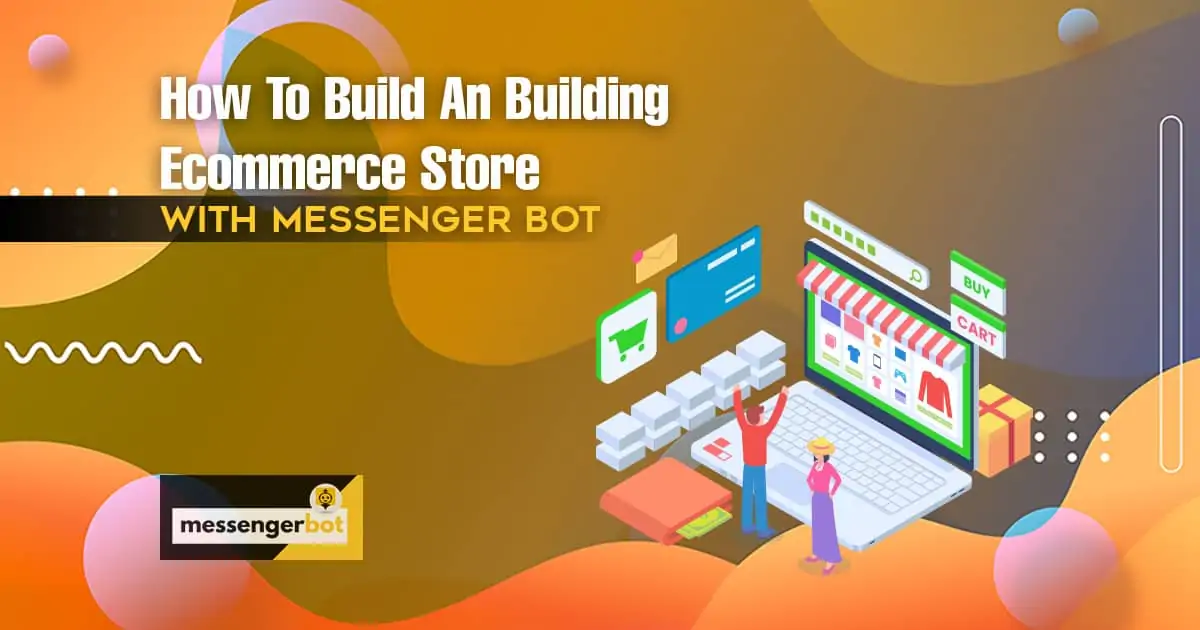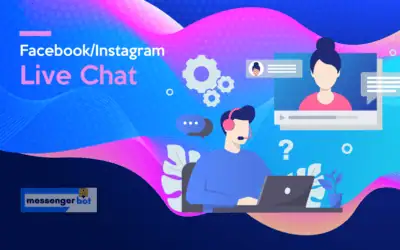Table of Contents:
How To Build An eCommerce Store With Messenger Bot
Log in to Messenger Bot Application. And in your Dashboard select Ecommerce then dropdown to click Ecommerce Store.

In Ecommerce Store Dashboard: It displays a summary of the statistics that will include:
- Total order: The number of items ordered on selected dates.
- Checked out the order: The number of orders that have been processed
- Total earnings: Total amount of earnings till the selected date.

Create store: You can create a new store by following the steps:
- Select an option from the top right of the screen. Click Create a store.
- Provide store information, select the page name.
- Provide the store name, email address, postal address, mobile|phone number.
- Upload Logo and Favicon.
- Provide Facebook pixel id and Google analytics id if you have.
- Set the status of the store.
- Provide a Terms of services.
- Provide a refund policy.
- Click, Create Store or Cancel.

Store Settings: It displays the information about E-commerce Store. It can be edited and updated at any time if changes may occur.
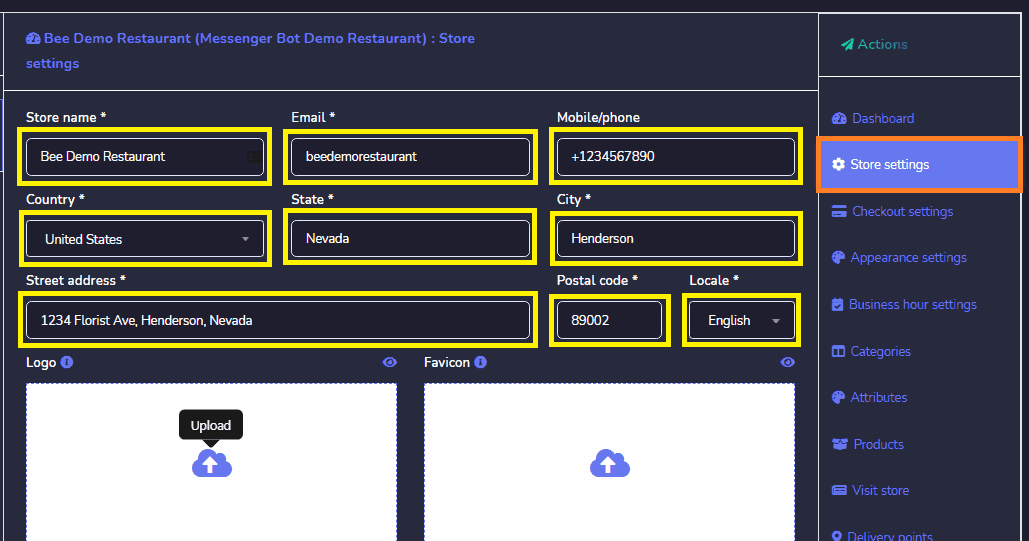

Checkout Settings: This allows you to adjust the settings of all payment accounts. You need to follow these steps below:
- Provide the PayPal email address and enable PayPal sandbox mode.
- Enter a stripe secret key and stripe publishable key and enable stripe billing address.

- Enter SenangPay Mearchant Id and SenangPay Secret Key. Then, Enable SenangPay Sandbox Mode. Click, details Senangpay return URL.
- Enter Instamojo Private API Key and Instamojo Private Auth Token. Click, Enable Sandbox Mode.
- Enter SSLCOMMERZ store id and SSLCOMMERZ store password. Then, click enable SSLCOMMERZ sandbox mode.

- Enter Mercado pago public key and Mercado pago acceess token. Select Mercadopago Country.
- Enter Mollie API key.
- Enter Xendit Secret API Key.
- Enter Razorpay key id and Razorpay key secret.

- Enter Paystack secret key and Paystack public key.
- Write Manual payment instructions.

- Checkout Payment Options: Choose what payment options that your customer can choose upon checking out their orders. From Paypal, Stripe, Razorpay, Paystack.Mollie, Mercado Pago, SSLCOMMERZ, Senangpay, Instamojo, Xendit, Manual, and Cash on Delivery.

- Currency & Formatting: Select the currency of your country with options on Right alignment, Two decimals, and Display comma.
- Tax & Delivery Charge: you can set up tax percent for all products and delivery charges.
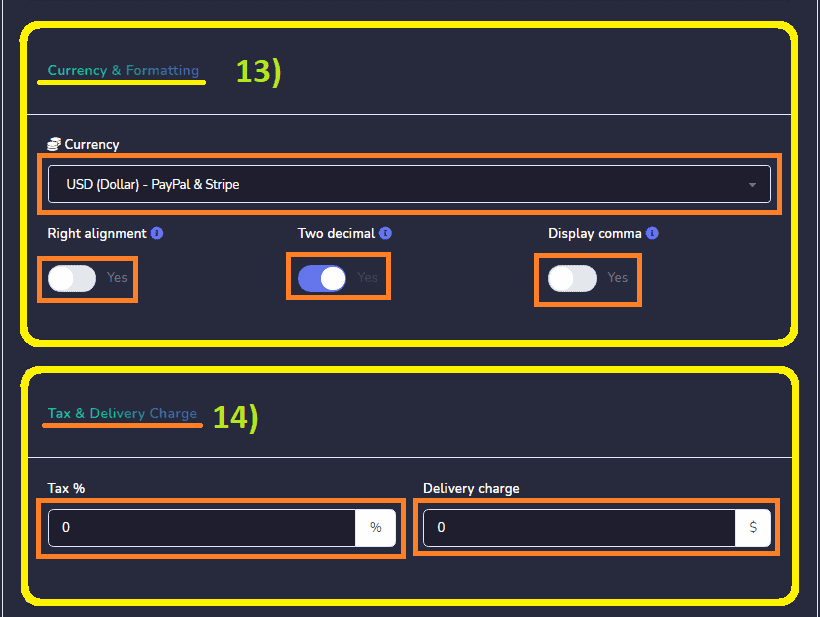
- You can also select Delivery Preference by Enabling Store Pickup, Home Delivery, Preparation Time, and Scheduled order.
- Login Preference: Enable Guest Purchase.

- Address Preference: Enable Checkout country, Checkout state, Checkout City, Checkout zip, Checkout email, Checkout phone, and Delivery Note.
- Click Save.

Appearance Settings: You can customize your eCommerce store. Like, Choose theme color, Product grouping, Product viewing, Product sorting, Font, Buy now button title, Store pickup title, Hide add to cart button and Hide buy now button. Then, click Save.

Business Hour Settings: You can choose Always open.

Or Select your opening time from Monday to Sunday. Then, click Save.

Categories: The categories for your stores appear in this section. You can perform the following actions:
- Edit the category.
- Delete the category.
You can also add a new category to the database by following the steps: Click, Add category from the top right of the categories screen.

A new category window will appear. Provide Category name, Add Thumbnails, and enable status to Active. You cancel or Save your category.

Attributes: The attributes for your stores appear in this section. You can perform the following actions:
- Edit an attribute.
- Delete an attribute.

You can also add a new attribute in the database by following the steps:
- Select Add attribute from the top right of the attributes screen. A new attribute window will appear.
- Select the store for which you want to create attributes.
- Provide the name for your attributes.
- Enter attribute values separated with commas. Select Attributes Status: Multi-select, Optional, and Active. Click, Save or Cancel your Attribute.

Products: The products option allows you to get access to all existing products. You can perform the following actions:
- View the product page by selecting the eye.
- Edit the product.
- Clone the product.
- Delete the product.

You can also add a new product to the database by following the steps:
- Add Product from the product screen. Provide your Product name.
- Enter your Original Price or Sell Price.
- Select a category for your product.
- Select your Attributes.
- Write about your Product description and your Purchase note.
- Upload your Thumbnail.
- Upload your Featured Images.
- Provide Item in stock.
- Enable Display stock to Yes.
- Enable Prevent purchase if out of stock.
- Enable your Status Online.
- Enable your Taxable to Yes or No.
- Then click, Save or Cancel your Product.

Delivery Points is a single mailbox or other places at which mail is delivered. It differs from a street address, in that each address may have several delivery points, such as an apartment, office department, or other room.

You can perform the following:
- Edit a point.
- Delete a point.

Click Add from the top right of the point screen. A new point window will appear. Provide the point name for your point and provide the point detail where the delivery happens. Enable an active status. Then, click Save or Cancel.

Coupons: The product option allows you to get access to all existing coupons. You can perform the following actions:
- Edit the coupon information.
- Delete the coupon information.
- You can choose the date range for this view as well.

You can also add a new coupon to the database by following the steps:
- Select Add from the coupon screen.
- Select the store for which you want to add the coupon.
- Then, Provide the product for which you want to add the coupon.
- Enable Coupon Type between Percent, Fixed Cart, and Fixed Product. Then, enter a code for your coupon and enter an amount for your coupon.
- Select an Expiry date and maximum usage limit for your coupon.
- Enable Activate Status and Free shipping.
- Then, click Save.

Signed-up Customers: You can find here the list of your Customer who signed up.

Orders: You can view the details of all orders from this screen. You can search for a particular order using the search bar or sort them date-wise for narrowing down the search. You can arrange them in any order by selecting the arrows in the header. You can also Download orders.

Clicking this icon will be redirecting you to the summary of the Order that you will all the details of the order and have an option to print it.

Order Overview with an option to print it.

Copy URL: You can copy your store page, order, product, and legal URL. Hover over the code, then select the Copy an option that appears over the code line.

Visit Store: You can visit the store by selecting this option. It will redirect you to the store.
The Store Overview. It has a Store product thumbnail with choices of the category to click on. Store Homepage, Cart, and Login option.

You can also choose what Messenger, SMS, and Email Notification you want to send. From Order Pending, Approved, Rejected, Shipped, Delivered, and Completed.

You can customize your Messenger, SMS, and Email notification.

Confirmation & Reminder: This displays the Messenger, SMS, and Email confirmation and reminder to be sent to the customer. You can also edit the content.

It also has 3 reminder options with time interval choices.
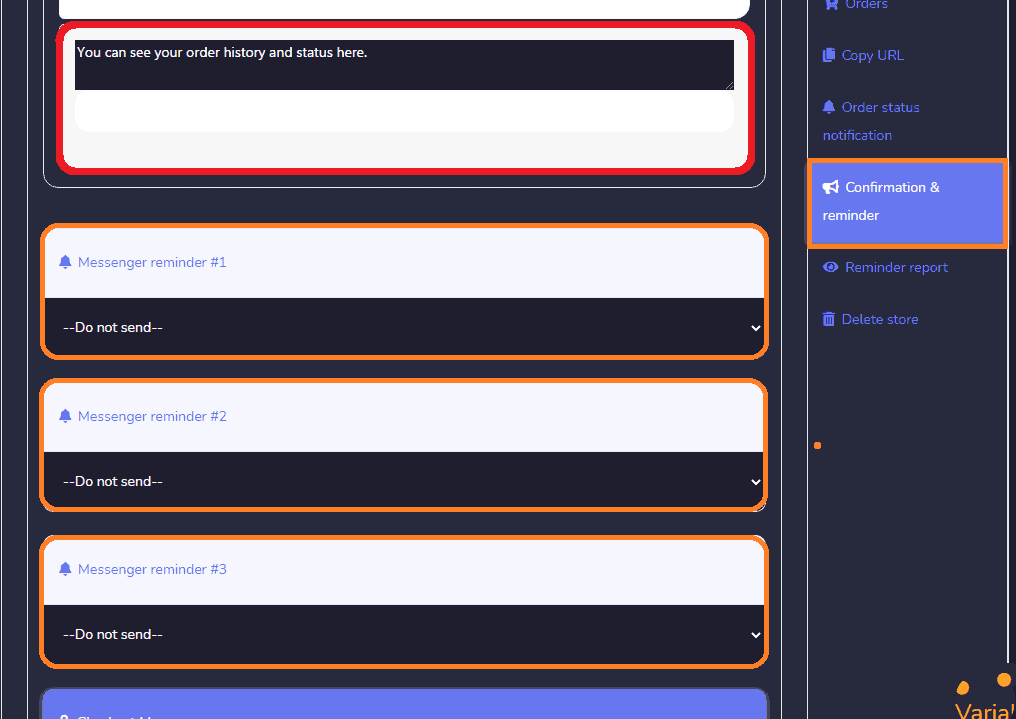
For checkout messenger. You can edit it anytime you wanted. Then, Save or Cancel.

Your Confirmation and reminder message have been updated successfully.

Reminder Report: Display the report of your sent confirmation Email, SMS, and Email to your Subscriber or customer.
You can also Delete Store if you want. But remember you cannot restore it after if you delete it. And when you delete your FB Page your store will be deleted too.

After creating your Ecommerce. Now, set up your Bot Reply. Back to Dashboard, select Messenger Bot, and click All Bot Settings. Then, Select Bot Settings. and click Actions.
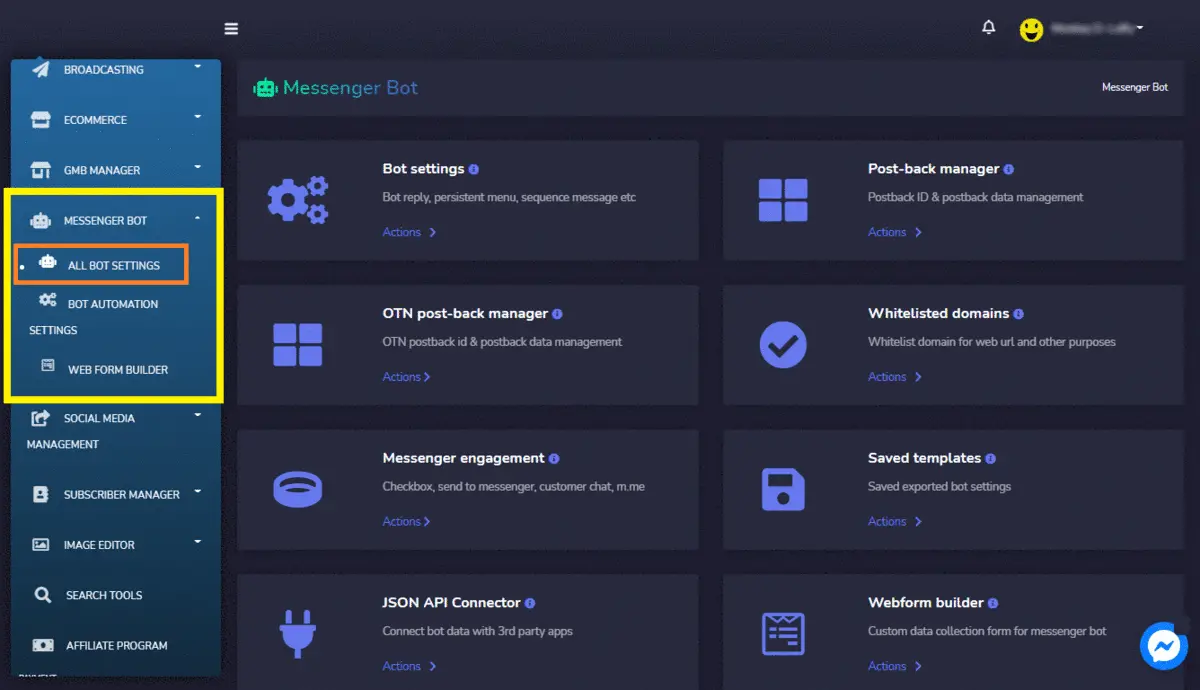
Select Facebook Page and Bot Reply Settings and click Add Bot Reply. Provide your Bot name and provide keywords separated by a comma. Select reply type and enable typing delay. Select your e-commerce store and products for the carousel|generic reply. Then, provide the “buy now” button text. Or you can add more replies and click Submit. Bot reply has been added successfully. Click, OK. Then, go to your Facebook Page to test the Ecommerce Store and bot reply.

Type the Keyword you created. This is the Bot Reply created. Click, Buy Now.

The overview of the “Buy Now” per product.

Detailed information about the product.

Home Overview of the Ecommerce Store in Facebook Messager. All the products will be seen here. In any category. An option to view by categories.

Overview of your Orders. It displays the status of all the orders you made.

Cart overview. All your orders will be seen here. Then, you can proceed with Checkout.
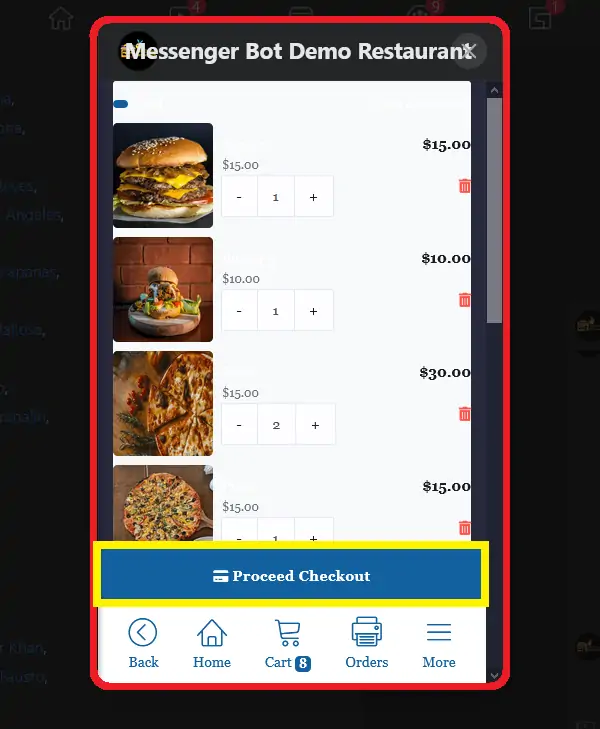
After clicking the proceed checkout. It will redirect you to payment options.

After choosing payment. Overview of your order after payment. It contains a message that your order has been placed successfully and is being reviewed.
It also contains all the detailed order with price per unit, quantity, and total per product. Order status. Payment Method chooses and Subtotal all the orders.
As well it has the Deliver to: Name of the biller. Delivery address and Email address.

Add Address: When the customer adds an address it will make it easy to check out every time they order. It will be their default address. An overview of Delivery Address Setup. After the buyer providing the details. They need to click Save the Address.

Now, click More. It will display the profile, delivery address, my orders, and terms|refund.


